

![]()
THE HISTORY OF THE SHEPHERD'S DOG
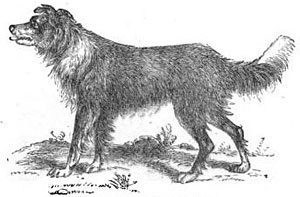
The Shepherd's Dog
from Chambers's Information for the People
by William & Robert Chambers, 1875
THE SHEPHERD'S DOG IN ANTIQUITY
[Please visit our History of the Shepherd's Dog Glossary for definitions of terms used in these articles]
When I set out to research the history of the shepherd's dog and to write the articles on these pages, I did not anticipate how difficult it would be and how little information I would find. One is struck time and again by the fact that shepherds' dogs are barely alluded to in literature. Folksongs, poetry, novels and history abound with pastoral references. Shepherds falling in love or the lonely life of the shepherd are frequent themes. Histories of the sheep and wool industry in Britain fill volumes, but the shepherd's dog, so much a part of the shepherd's life, is hardly ever spoken of. In his landmark book, The Drove Roads of Scotland (Thomas Nelson & Sons Ltd., London, 1952, 1953) A.R.B. Haldane says "Dogs were extensively used in droving,...although there is curiously little mention of them in contemporary records..." Why is that?
One explanation is that it was not ordinarily shepherds that wrote about pastoral life (a notable exception being James Hogg); and while to a shepherd his dog may be important, this fact might have been completely overlooked by contemporary writers. Could it be that shepherds' dogs were merely considered tools--indispensable but not worth singing about? "It is not surprising we know so little," says Shirley Toulson, "for no one bothers to record the ordinary" (The Drovers by Shirley Toulson, Shire Publications Ltd., Aylesbury, 1980).
These curious facts make understanding the role of sheepdogs throughout history difficult, and writing about them becomes a complex task.
The Border Collie is my breed, hence the title of this website. However, my intention with these articles is to present the history of the shepherd's dog in its entirety, not just the history of the Border Collie. I also hope to include the history of livestock guardian dogs (LGDs). LGDs are not herding dogs, but they are shepherd's dogs nevertheless. It is also likely to be the case that LGDs were the original shepherd's dogs, long before someone thought to use a dog for herding. With that in mind, let us go on to examine the shepherd's dog in Antiguity.
The transition from hunting and gathering to settlement and agriculture is sometimes referred to as the "Neolithic Revolution", the passage from the Paleolithic or Old Stone Age to the Neolithic or New Stone Age. This was no single event, but took place in various parts of the world at different times. Generally speaking, it is considered to have begun at about 8,000 BC. Some animals, however, were domesticated before the Neolithic Revolution, and the dog is among those. Some archeological records seem to point to a date between 10,000 and 20,000 years ago for the domestication of the dog, and it is what is currently generally accepted. However, other records tell a different story and place the earliest dogs further back in time.
DNA evidence has raised some interesting questions, with the implication being that the dog may have begun to break away from the wolf as long ago as 100,000 years (Vilà C., et al. "Multiple and Ancient Origins of the Domestic Dog", Science, 1997), long before domestication; and that domestication happened more than once and in different times and places. Whatever the case, it is beyond the scope of this article. What we do know is that domestication of the dog came before the Neolithic Revolution. It is posited that dogs were first used to aid in hunting, but that, too, is still up for debate. Once sheep and goats were domesticated, between 11,000 and 7,000 BC (again, not a single event), nomadic pastoralism (transhumance) evolved with the need to search for fresh pastures; and it is probable that dogs were needed to help with that as well. In fact, it appears likely that dogs used for managing sheep developed alongside the domestication of sheep. Whether these were herding dogs or guardian dogs, or both types, we may never know.
The Shepherd's Dog in Ancient Mesopotamia (ca. 2900-700 BC)
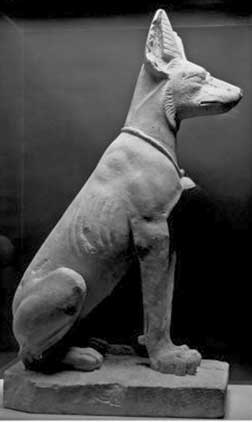 Left, a statue of a Dog from Mesopotamia, circa 5000-1000 BC. Note how like the god, Anubis, below, from Egypt, this dog is. It shows how the cultures of this region influenced each other.
Left, a statue of a Dog from Mesopotamia, circa 5000-1000 BC. Note how like the god, Anubis, below, from Egypt, this dog is. It shows how the cultures of this region influenced each other.
Mesopotamia was an area in the Tigris-Euphrates river system, corresponding to modern day Iraq and part of Syria, Turkey, Iran, and Kuwait. Considered the "Cradle of Civilization" (at least by some Western historians), it was part of the "Fertile Crescent" which consisted of Mesopotamia and the Levant (the eastern Mediterranean between Anatolia and Egypt), and thought to be where agriculture began and sheep were first domesticated. However, it has been shown that agriculture arose in different places at slightly different times, and that the domestication of sheep took place likewise in different places at different times.
Sumer (or Sumeria) was an ancient civilization of Early Bronze Age (4th-3rd or 2nd millennium BC) southern Mesopotamia. The other civilizations that made up Mesopotamia were the three Semitic empires of Akkadia, Babylon, and Assyria. The Sumerians spoke a language isolate (a natural language with no relationship to other languages) and was a male-dominated society. They wrote in cuneiform and hieroglyphs, which were the oldest example of writing on earth. Their early pictograms suggested that sheep, goats, cattle, pigs, and donkeys (onagers) were domesticated, and they had the wheel and used carts or chariots.
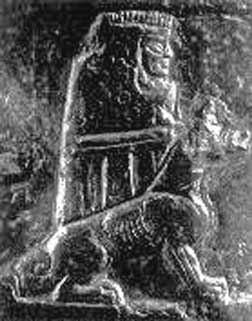 Right, the goddess Gula on a stele with her dog, dated to the reign of Babylonian king Nabu-mukin-apli, 978-943 BC. Drawing ©Stephane Beaulieu, after Black and Green 2003. Gula is one of a number of healing goddesses of the region that is associated with dogs.
Right, the goddess Gula on a stele with her dog, dated to the reign of Babylonian king Nabu-mukin-apli, 978-943 BC. Drawing ©Stephane Beaulieu, after Black and Green 2003. Gula is one of a number of healing goddesses of the region that is associated with dogs.
Dogs are commonly seen on seal designs of the period, sometimes sitting beside a enthroned goddess, sometimes by themselves supporting the symbol of the crook. The crook is the symbol of the god Amurru or Martu who was a personification of the nomadic peoples of the desert. He is sometimes shown carrying a crook, appropriate to a god that accompanies pastoral nomads (Black, Jeramy A. et al. Gods, Demons, and Symbols of Ancient Mesopotamia: An Illustrated Dictionary, University of Texas Press, 2003). One of the earliest reference in literature to a shepherd's dog, in "Dumuzid's Dream", which comes from ancient Sumeria.
DUMUZID'S DREAM
from Sumerian Literature ca. pre-2900 BC
"A sir-kalkalfor the dead Dumuzid"
(sir is a Sumerian word meaning a type of song; and sirkalkal is a Sumerian word meaning a type of composition
The Archaeomusicology of the Ancient Near East by Richard J. Dumbrill, 2005, Trafford Publishing).
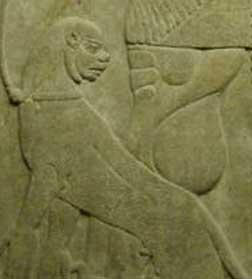 It is difficult to tell if this Sumerian animal is a dog or a lion, but it is likely a dog. The people in this region seemed to have believed that the two were related, so it could be either or both. At any rate, it is unlikely to be a herding dog, though perhaps it is a guardian dog.
It is difficult to tell if this Sumerian animal is a dog or a lion, but it is likely a dog. The people in this region seemed to have believed that the two were related, so it could be either or both. At any rate, it is unlikely to be a herding dog, though perhaps it is a guardian dog.
Dumuzid was a shepherd and a mythical, prehistoric, pre-dynastic Sumerian king (prior to ca. 2900 BC which is when the Early Dynastic period begins). According to some sources, he is considered a precursor to the Babylonian god Tammuz (Wikipedia, et al). In these interpretations, Tammuz is either a nature god, who protects agriculture and flocks and personifies fertility, or he is a sun god. In any case, similar to such gods of other mythologies, he dies at midsummer, and is ressurected the following spring, and this appears to be the case for Dumuzid as well. According to others, this narrative focuses "on the goddess Inana's journey to the Underworld, her rescue and return, and her pact with the Underworld gods, whereby she is replaced in the Underworld by her lover, the god Dumuzid." The Literature of Ancient Sumer
by Jeremy Black, Graham Cunningham, Eleanor Robson, Gabor Zolyomi.
Translated by Jeremy Black, Graham Cunningham, Eleanor Robson, Gabor Zolyomi
(2004, Oxford University Press).
In the story, Dumuzid lies down to sleep and dreams. When he awakens, he is terrified and relates his dream to his sister, who is a "wise woman who knows the meanings of dreams". Dumuzid says that in his dream, among other things, water was thrown on his coals, his holy drinking cup was torn down from its peg, his shepherd's stick disappeared, an owl took one of his lambs, he died, and haunted the sheepfold.
His sister interprets the dream to mean that terrible things will befall him and that she will morn him. She sends a friend to look for the villains (demons of the Underworld [ibid.]), and the friend reports that they are on their way. She tells her brother, who says he will hide and begs her not to tell them where he went. She responds with:
"If I reveal your whereabouts to them, may your dog devour me! The black dog, your shepherd dog, the noble dog, your lordly dog, may your dog devour me!" [ibid.].
Spoiler alert: The demons come for Dumuzid, but his sister will reveal nothing, so they go to her friend, who accepts their bribes and tells them where the shepherd/king/god is hiding. They find him and prepare to kill him, but he prays to Utu, a god, who turns his hands and feet into the feet of a gazelle, and so he escapes. Unfortunately, this, as in all the stanzas in the "song for the dead Dumuzid", happens three times, and the third time he cannot escape and is killed and his sheepfold is destroyed.
Since Dumuzid's sister used "dog" in the singluar, presumably all the adjectives she uses apply to one particular dog, Dumuzid's "shepherd dog". He is black so it may be safe to say that he is a herding dog rather than a guardian breed, since many LGDs--but not all--are white or light colored, but this is assuming a lot since this story takes place almost 5,000 years ago, so I'll leave you to draw your own conclusions. Whether he is a herding dog or guardian dog, this may be the earliest literary mention of a shepherd's dog.
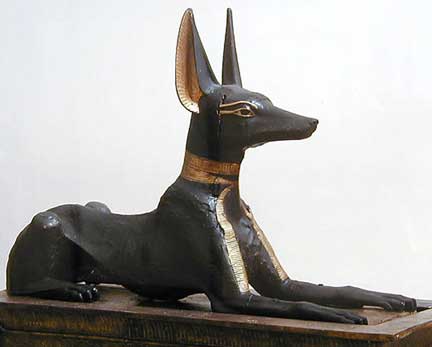
Above, a statue of the Egyptian god, Anubus, who is portrayed as a canid and thought to be a jackel.
The Shepherd's Dog in Ancient Egypt (3150 BC to 31 BC)
Herodotus, a Greek historian who lived ca. 484-425 BC, tells us that when a cat died in Egypt the household shaved their eyebrows, but when a dog died they shaved their whole body and head. Dogs were mostly for hunting or as pets, but there may have been sheepdogs as well, perhaps both herding dogs and livestock guardian dogs. The keeping of sheep and goats was of secondary importance in Ancient Egypt, as cattle were more economically vital. However, dogs had individual names and were often buried with their masters, and one of the names found on a dog burial was "Good Herdsman". Certainly, there is nothing conclusive about this, but why else would he be called it, if that were not his vocation?
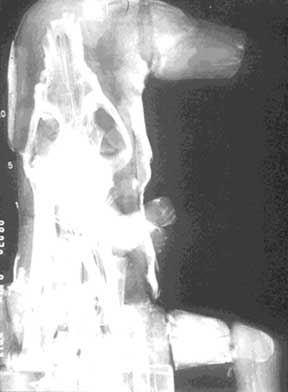
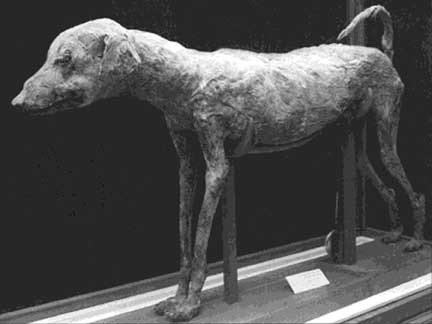 Left, An x-ray photo of a wooden image of Anubis containing the skeleton of a dog.
Left, An x-ray photo of a wooden image of Anubis containing the skeleton of a dog.
Right, A mummy of a dog, probably a Saluki-type of coursing hound.
Animals, like humans, were mummified in Ancient Egypt, and it is not unusual to find dog mummies and other effigies to dogs. Dogs were also offered to Anubis, the god of mummification and the afterlife, who was depicted as a jackal. Whether any mummies specifically of sheepdogs were found is unknown.
The Shepherd's Dog in Classical Rome and Greece (8th C. BC through 5th C. AD)
Marcus Terentius Varro (116BC-27BC) was a Roman scholar and writer. His literary output was very large. Little of it survives but one complete work and many fragments. His agricultural book, Res Rusticae (Rural Matters), was intended as a practical manual on husbandry. It is often quoted as mentioning the shepherd's dog, but unfortunately for us, the dog Varro describes is of the guardian type, not of the herding type. Still, it is worth mentioning. It appears that perhaps only guardian types were used for sheep in Rome, because large predators existed that needed to be guarded against. Varro said:
"There is left...of the discussion of quadrupeds only the topic of dogs; but it is of great interest to those of us who keep fleece-bearing flocks, the dog being the guardian of the flock, which needs such a champion to defend it. Under this head come especially sheep but also goats, as these are common prey of the wolf, and we use dogs to protect them... "In the first place, they should be procured of the proper age, as puppies, as dogs over age are of no value for guarding either themselves or sheep...; preferably white in colour, so that they may the more readily be distinguished in the dark..; It is better...to buy from a shepherd a bitch which has been trained to follow sheep, or one that has had no training at all; for a dog forms a habit for anything very easily, and the attachment he forms for shepherds is more lasting than that he forms for sheep... "The number of dogs is usually determined by the size of the flock; it is thought to be about right for one dog to follow each shepherd. But the number varies with the circumstances; thus in countries where wild beasts are plentiful, there should be more, as is usually the case with those who escort the flocks to summer and winter pastures through distant woodland trails. On the other hand, for a flock feeding near the steading two dogs to the farm are sufficient." [Some material from the web pages of Bill Thayer who has explicitly stated it to be in the public domain; likewise from Wikipedia.]
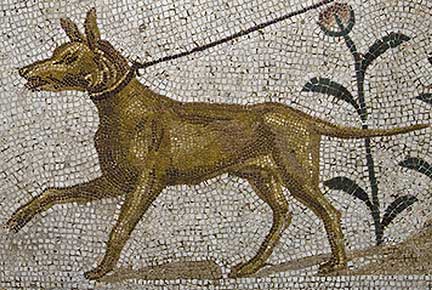 Right, a mosaic of a Roman dog. The type is also ambiguous.
Right, a mosaic of a Roman dog. The type is also ambiguous.
I believe the implication is that the dogs were habituated to follow the shepherd, and the sheep accustomed to following the dogs, thereby obviating the need for a herding dog.
Quintus Horatius Flaccus (65-8BC), better known as Horace, was a lyric poet, possibly the greatest of Latin poets. He was the son of a freedman and farmer, served in the army, became an official of the Treasury, and thereby was able to practice his poetic arts. In one of his poems, Horace envisions himself as a sheep-dog who "pricks up my ears and chases through deepest snow after whatever beast will run from me".
Lucius Lunius Moderatus Columella (4-70AD) another Roman writer who took up farming after a career in the army, also wrote a book about agriculture. In his 12 volume De Re Rustica (About Rural Matters) he tells us that an "all-white dog is recommended for the shepherd to avoid mistaking it for a wolf in the half-light of dawn or dusk" and that "the sheep dog...should be long and slim, strong and fast enough to repel a wolf or pursue one that has taken its prey."
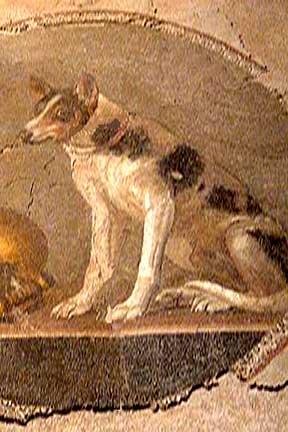 Left, a mosaic of a dog from the Alexandria Library which looks like it could be a smooth-coated, patterned-white collie-type dog. There's no indication of scale, so it could be a smooth-coated terrier.
Left, a mosaic of a dog from the Alexandria Library which looks like it could be a smooth-coated, patterned-white collie-type dog. There's no indication of scale, so it could be a smooth-coated terrier.
I would like to leave this section with a question. Oppian of Apamea, a Greek poet, wrote a poem on hunting, around 211AD. He is said to have exhibited considerable knowledge of his subject and close observation of nature. [Wikipedia] Oppian tells us that, for the hunter, the black and white dogs of the farmer and shepherd are not desirable. [James Grout's Encyclopaedia Romana, 2009] Could this phrase indicate the presence of a collie-type dog, or at least a herding dog, in Greece during the classical period?
The Shepherd's Dog in Prehistoric and Roman Britain
The Romans invaded Britain twice, once in 55-54 BC, and again, more successfully, in 43 AD, when the Celtic tribes were defeated or pushed further north and west over a period of about 30 or 40 years. Britain came under increasing attacks from Germanic tribes beginning in the 4th century, and Rome had begun to withdraw. Tradition has it that by the early-to-mid-5th century, Rome had completely abandoned Britain. By 600 AD, the Saxons occupied Lowland Britain.
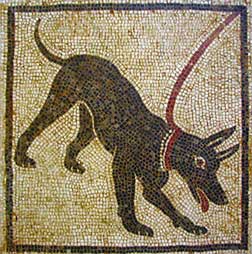 Right, a mosaic of a dog from Pompeii. It is not clear what type of dog this is.
Right, a mosaic of a dog from Pompeii. It is not clear what type of dog this is.
The Romans brought sheep and sheepdogs with them and were known to have a well-organized wool textile industry in Britain ["The History of Sheep Breeds in Britain"Michael L.. Ryder, Agricultural History Review, December 1964]; however, when they arrived, there was already a wool industry in place. This was encouraged by the Romans, who had a taste for fine British woolen cloth. There is no reason to believe that this economy died with the Roman withdrawal. On the contrary, archaeological evidence points to an increased presence of sheep during the Anglo-Saxon period ["Sheep, Horses, Swine, and Kine: a Zooarchaeological Perspective on the Anglo-Saxon Settlement of England" by Pam J. Crabtree, Journal of Field Archaeology, Summer 1989. Published by Boston University]. So, while the end of the Roman period may have caused the wool industry to stagnate to a certain extent, and the invading Germanic tribes may have decimated it at first, Britain's wool industry soon recovered and began to expand.
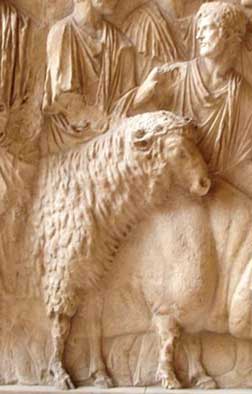 Left, a detail from a 1st century Roman stele in the Louvre. It shows a ram and other animals being led to slaughter. Too bad there isn't a sheepdog in this high relief sculture.
Left, a detail from a 1st century Roman stele in the Louvre. It shows a ram and other animals being led to slaughter. Too bad there isn't a sheepdog in this high relief sculture.
It is difficult to say just when white domestic sheep became established in Britain. It is possible that they were introduced to the British Isles by the Celtic Belgae of Gaul during the Iron Age (approximately 800 BC to 100 AD in Britain); or perhaps much earlier, during the Bronze Age (2100 to 750 BC), when forest clearance was well under way on the Downs of southern England. It is also possible that the Romans themselves brought white sheep with them when they conquered Britain. In any case, during the Roman period there were two types of sheep in Britain, the so-called Roman improved white sheep, and the small, brown Iron or Bronze Age sheep typified by the Soay breed of St. Kilda in the Hebrides. In fact, the Soay so resembles the early Iron Age sheep in fleece and skeletal structure that it has been described as a living fossil. [J. P. Wild, "Prehistoric and Roman Textiles", The Wool Textile Industry in Great Britain, Routledge & Kegan Paul Ltd., 1972]
There is much available evidence of a wool industry in Britain prior to and during Roman occupation, most of it in the form of sheep shears, textile tools (like spindles, loom parts, and wool preparation tools), and cloth fragments; and of course the presence of sheep bones. A more detailed discussion of this is outside the purview of this article. There is no real information on shepherd's dogs, though the bones of dogs have been found. The Romans, as we have seen, developed pastoral dogs, and undoubtedly brought them with them to Britain. It seems likely, however, that the existence of a wool industry in Britain meant there were already native sheepdogs, probably both herding and guardian types (as there were still wolves) at the time of the Roman conquest.
The Shepherd's Dog in Ancient Europe and Asia
Much as I would like to cover this region here, it is covered in another page on this website:
Introduction to the Herding Dogs of Europe and Asia
THE BIBLE
Taken strictly as literature, the Bible is likely to have been written down after the period when Dumuzid's Dream (above) was supposed to have taken place. Many people have pointed out that the Bible does not mention a dog with the shepherds. In Biblical times, even though shepherds likely did have dogs, among Jews and Muslims dogs were considered unclean and it certainly seems unlikely, therefore, that they would be mentioned in the sacred text of the Bible.
However, in his Encyclopaedia Biblica ("a Critical Dictionary of the Literary, Political, and Religious History, the Archaeology, Geography and Natural History of the Bible", Adam & Charles, London, 1899), the Rev. T. K. Cheyne (Oriel Professor of the Interpretation of Holy Scripture at Oxford) tells us otherwise:
The shepherd's dog is mentioned in Job 30-1...but [the] passage [does not] vouchsafe the dog in any friendly words.
Under the heading "Pariah dog", the book mentions that
...in the country they are trained by the shepherds and farmers to act as sheep-dogs (cp Job 30-1). Not much good, however can be said of the latter: they are 'a mean, sinister, ill-conditioned generation,' whose use consists in barking at intruders and warning the shepherds of any possible danger. In appearance they resemble the Scotch collie, and are said to be intelligent, and sagacious when trained. Rabies is almost, or entirely, unknown among them...
In the above paragraph, Rev. Cheyne is certain to be speaking of the shepherds' dogs of his own day (the 19th century), that he may have seen while visiting the Holy Land; though one might infer from it that he believes that the pariah/shepherd's dog has descended in a straight line from the dogs of Biblical times. However, according to Dr. Boris Yakobson, Head of the Department of Rabies, Division of Pathology, Kimron Veterinary Institute, Israel, "rabies has been rife in the Middle East since ancient times". Given the danger of rabies, it isn't difficult to imagine why people in Biblical times considered dogs unclean and kept away from them. It is equally imaginable that shepherds, when they had a good dog, would breed it and pass the progeny on to their own descendants, at the same time keeping their working dogs close and as much as possible away other dogs and from the threat of rabies.
More when we get it!
Copyright 2008 by Carole L. Presberg
THE OTHER WEB PAGES WE MAINTAIN
These web pages are copyright ©2013
and maintained by webmeistress Carole Presberg
with technical help from webwizard David Presberg
ALL RIGHTS RESERVED
If you are interested in using ANY material on this website, you MUST first ask for permission.
You may email us at carole@woolgather.org.